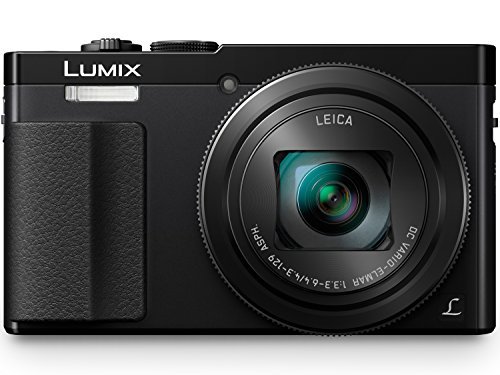
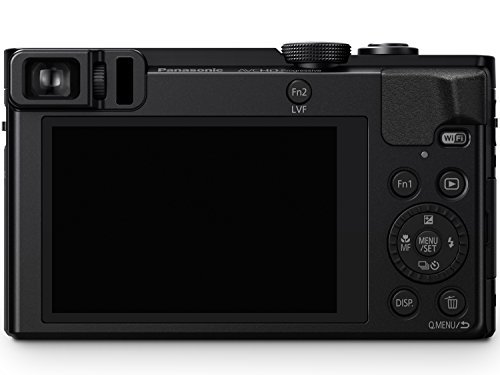
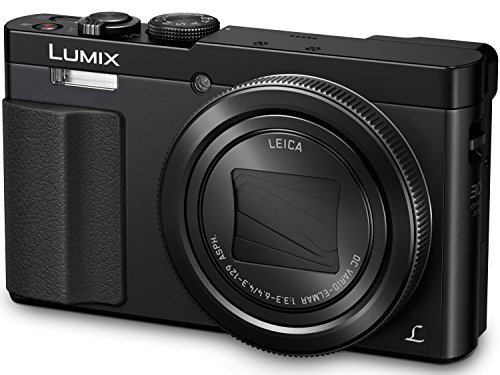
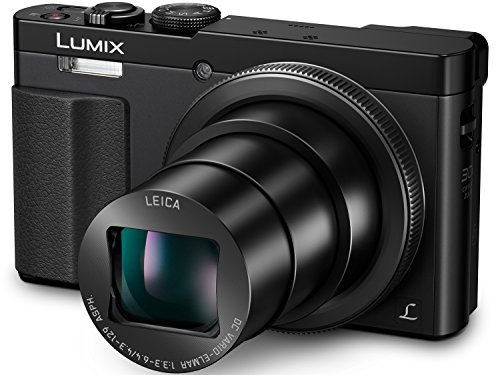
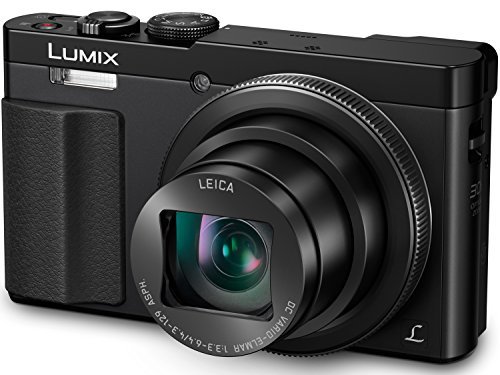
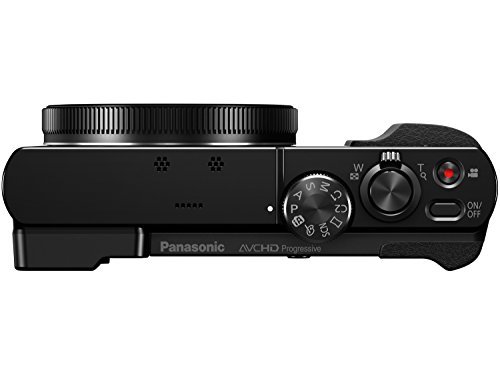
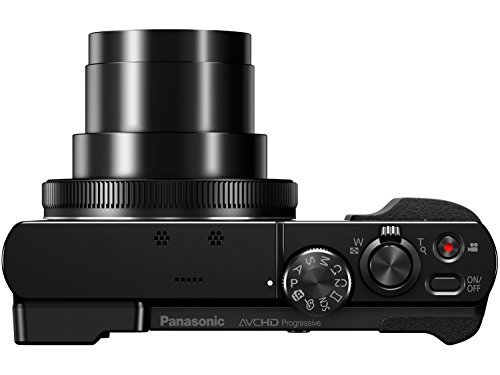







Built-in eye viewfinder eliminates outdoor glare on sunny days
Style:ZS50K | Color:Black LUMIX 30X Travel Zoom Camera with Eye Viewfinder
I’ve been looking for a good quality point-and-shoot light-weight camera that fits in my pocket, has a long zoom, has a good viewfinder, one that travels easily, and not too costly. Turns out there aren’t many choices that fit all these criteria. I enjoy photography, am a highly experienced photographer although not a pro, and have a really good camera with interchangeable lenses, etc. which I use when I want to get top quality pics and need to have a lot of control over focus, depth of field, mounted flash, etc. However, when traveling by air, hauling all that equipment around, taking up space in carry-on luggage, etc. tends to make me leave the really good camera at home. With pocket cameras I’ve used, I really miss having a viewfinder. I find them awkward to hold steady, and difficult to see on the backside LCD panel exactly what I’m getting in bright light or when I need to follow and catch fast moving objects (e.g., flying birds), particularly when the zoom is extended. I’ve been frustrated when I can’t get the pics I want with those pocket cameras.So I went out on a limb, spent a little more than I had intended, and got the new Panasonic Lumix ZS50, which I preordered. I seldom buy new models of anything when they first come out, so for me this was a bit of a gamble. However, I have been pleasantly surprised so far with this little camera. It has an amazing feature set for something that really does fit in my pocket, has a good viewfinder and plenty of zoom. I have not given it a true test yet, taking thousands of pics under a wide range of lighting and distance conditions, so I will have to report back later.What I like so far:- camera takes good pictures in the auto mode under most conditions- viewfinder works well in bright light conditions, and switches on automatically when you hold it up to your eye- zoom and focusing are relatively quick and quiet- the steady shot feature works well, especially in shooting video- flexibility and control in non-auto modes (e.g., program mode when I want more control over depth of field, etc.)- several different focusing and exposure methods- ability to save images in RAW format as well as JPEG- the right hand grip feels fairly secure for such a small cameraWhat I don’t like so far:- viewfinder is off-center when holding the camera, compared with what I’m used to with larger cameras, so I can’t grip it as securely with my left hand (because my nose is in the way) BUT I love having that viewfinder anyway!- lots of MODES in the menu system for settings (I eventually found that I needed to switch to program mode in order to find settings I was looking for, e.g., to save pics in RAW format, change focusing methods). Can be confusing at times, a bit of a learning curve.- the LCD display sometimes suddenly turns off and then back on, which had me baffled initially when playing back pics. Turns out I had moved a finger too close the the viewfinder, which fooled the camera into auto-switching to the viewfinder.- when taking flash pictures, it’s too easy to partially block the flash somewhat on the right side, which casts a shadow–just something I’ll need to get used to by gripping a little differently on the right side (I’ve had this problem with other pocket cameras that don’t have pop-up flashes). Works fine when I move my fingers down on the right-side grip a little.- when doing the wi-fi setup, I could not enter user names or passwords that had spaces in them–I am stumped on this, and cannot understand why Panasonic would not allow selection of the ‘space’ character!!!- wi-fi will not transfer pics in RAW format, so have to use cable or take out memory card and plug into my computer–again, why? Granted 15 Mb per pic will take a lot longer to transfer than smaller JPEGs.- cannot charge battery outside of camera and must use Panasonic’s cable- not sure yet whether 12 megapixel sensor will be enough resolution for severely cropped pics, printed at 8x10 in. or largerAll in all, this is hands-down the best pocket camera I’ve owned and used. Why not 5 stars? I’ll need to really give it the “road” test by taking thousands of pics under a wide range of conditions. Haven’t had time to do this yet, and plan to edit this review later when I have.Added Comments: April 26, 2015I’ve changed my rating to 5 stars now, after taking several hundred pictures under varying conditions. Here are my further observations:- Indoor pictures with flash turn out fairly well. There are still sharp background shadows from objects illuminated by the flash, but that is to be expected with a direct flash (compared to one with indirect lighting, e.g., by bouncing light off the ceiling).- outdoor pictures are quite good on the whole. The 30x zoom certainly provides some additional flexibility, and I have not had issues with camera shake when the zoom is extended.- the one very challenging condition I was somewhat disappointed with was photographing fast flying pelicans at a distance on a very windy, overcast day. Many of the photos of the birds were taken at distances of several hundred yards up to half a mile, using the zoom extended out to 30x. I WAS able to track the birds relatively easily using the viewfinder. When later viewing the images with significant cropping on a flat screen HDTV, clarity of the images left something to be desired–a bit fuzzy on the edges of the birds against the cloudy sky. This is a very challenging set of circumstances–even with a good DSLR camera with a long telephoto lens, it would be challenging to get high quality pics. All in all, the Panasonic ZS50 did a remarkable job, considering the distance involved, with background of a cloudy sky, the speed of the flying flock of birds, and the fast panning required. The severely cropped images of the high flying birds still allowed my wife to identify them as white pelicans by comparing with pictures in her bird book.- I took some pics of blossoms and flowers with the camera just a few inches away, using the close-up focus setting on a sunny and very windy day. These came out exceptionally well. I was very pleased with the results. The pictures were quite stunning on a flat screen TV.All in all, I am quite impressed with this pocket camera, and enjoy taking pictures with it, since it is so light, has a decent viewfinder, and takes good photos. I use the Program mode mostly, rather than the Auto mode. Of course, I can get great pics with my really good camera, but I’ve invested roughly 4x as much for the body, lenses and external flash unit. On the other hand, this Panasonic ZS50 fits in my pocket, is easy to use, and costs a lot less.
The Panasonic ZS50 is an amazing camera. The images and video are the best I’ve seen out of a very small sensor small camera. What makes the camera unique is the beautiful EVF viewfinder, while small is bright; and sharp. Having an EVF (electronic) viewfinder improves the image quality because holding the camera against your head at eye level, steadies the camera almost as much as the built in image stabilization. The resulting view is closer to what your eye sees,and you don’t get that sun glare that will wash out an LCD screen. The EVF shows the display settings and you never have to remove your from the EVF to view the resulting image. This saves time and allows you to quickly adjust settings and snap another image if you are unhappy with your image.The image stabilization is excellent. It’s possible to get sharp images even at the full zoom. The most amazing part about this camera is the low light capability because of Panasonic’s choice of 12 megapixels rather than the higher 18 megapixels on previous models. Each pixel is much larger and as a result more sensitive to light. I tested ISO’s up to the maximum and was pleasantly surprised. Images are very good up to 1600 and 3200 was marginally acceptable*(purists might disagree) There is some noise but not enough to spoil the image. Images taken during the day at ISO’s between 100 and 400 were routinely excellent. You always want to keep the ISO low for best image quality. During the day I set the maximum ISO at 400 and raised it to 1600 in lower light. If you are into IA setting, no need to worry about the ISO setting. Note: Noise increases as the ISO is raised and is very visible without magnification between 3200 and 6400, .The camera in most settings including IA worked very well. If you want the camera to choose the settings for you, then set the camera to IA and the results will be very consistent. It won’t always select the perfect setting but most of the time it should work fine. If you are a manual only shooter, you are in luck too because there is A, S and M settings as well as multiple custom settings which are very easy to set. I like to use custom settings. I use one for landscape, one for shadows, one for low light and one for motion. The one bad part of changing individual settings is that if you forget to change them back, the results can be disappointing. That is a good reason why new camera users should start with IA and then experiment with other settings. P is a very safe setting because it allows you to change some settings without altering the basic exposure. The P setting is a favorite for many users.The scenic settings can also be helpful to a beginner and there are lots of them in this camera and they work great. There is a separate Panorama setting that is very easy to use and allows wide angle views like a super wide angle lens. The faster you move the camera, the narrower the resulting strip. Overall it’s fun to use and works great. There is a 3D setting which I couldn’t really see much of an effect but the image did standout.The most important features of the ZS 50 are the big zoom range of 24 wide angle to 740 zoom, and the EVF. There are no other small cameras with these two features. The images at full zoom and hand held came out sharper than I expected in good light. This sharpness in the image was only possible with excellent image stabilization and helped by using the viewfinder. I tried using the camera using just the LCD display. The fully zoomed images were much lower in quality (much softer and some were blurry). I personally cannot hold a camera steady with the camera stretched out like everyone does with their smartphone and tablets. Perhaps you can, but few can do it well. It’s always best to use a tripod when using a big zoom or when taking macro shots but that defeats the advantage of a small camera.The video is also good but does need better lighting that you get during the daylight. It’s OK inside with plenty of good lighting and pumping up ISO to no higher than 800. The sound quality was fine as long as it isn’t too windy. The stereo mike is on top of the camera. There is no port for an external mike. This is often seen on much more expensive or much larger cameras. I got much better video indoors when I added a small LED light panel which significantly improve the video quality. If there is a lot of good lighting in the room, extra lighting isn’t required or necessary.Another interesting feature is the ability to change the image in camera to get a different look. Take an image and transfer it to sepia or black and white and many other effects. It’s fun but it won’t destroy the original image. This feature is available on other cameras but needs to be set before you take your image.The camera itself seems speedy enough from image to image but it cannot match the much more expensive Sony RX100iii for image quality with its larger 1 inch sensor or camera speed. The RX also has a small popup EVF that is quite sharp but less convenient than the EVF on the ZS50. The Sony cost 2X the ZS50. You may wonder if the ZS50 is worth $400. The answer is yes!…it’s a bargain for its capability and performance. Panasonic was able to price the camera at this low price by making some minor quality and feature sacrifices. The camera feels very solidly built mainly of plastic. Some people complained by the plasticy feel but it seems very solid for me. I’m guessing $400 is the most many people will spend for a camera and Panasonic attempted to offer as much as they could to keep to that top price.Want to spend $800 to $2000, then look elsewhere but plan on lugging a much heavier camera and spending even more for lenses which typically cost much more than the price of this entire camera with its lens attached. There are some smaller models in this price range but none offer the EVF, big zoom and feature set of the ZS50.Some good points to consider:1. The camera is very easy to hold and grip and keep steady especially if you use the EVF.2. The EVF is very sharp and clear and perfectly placed to view with your right eye (much less so for your left eye).3. Enhanced low light capability because of larger pixels and lower 12 megapixel count.4. The buttons, 4 way controller and wheel feel good and are easy to use.5. The camera has a nice sold feel and feels like a quality camera. It’s light enough and small enough to put in your pocket. I use a cheap Targus bag and it fits with sufficient looseness so it’s easy to remove. Avoid a tight fitting bag which can cause an accident…camera drop. I carry the bag on my belt along with my phone so it’s ready to go at any point.6. Excellent images and video with good to excellent lighting7. Much better low light capability than previous versions of camera made possible with new MOS sensor which has much larger pixel size to capture light but has fewer of them, 12 megapixels. It should produce good 11 by 14 prints.8. Lots of extra easy to use features like Panorama mode9. Nice control ring on the front of the camera for control certain features like focus or exposure compensation. It’s easy and works great10. Wifi, which is useful for externally controlling the camera and transfer of images and NFC for direct transfer of images.11. Level Guage helps keep the horizon level and is a great aid in keeping images straight.12. Composition guides like the rule of third and 12 variants are useful for more interesting images.13. Builtin memory will hold a few images if you forgot to put in your SD Card14. Focus peaking and other higher end features help in exposure control15. 30X zoom, ranges from 24 wide angle up to 700 plus zoom. This is an extremely useful very wide range.The not so good points.1. The flash is placed exactly where you want to place your finger or fingers and is really a poor place to place a flash..2. Has a RAW feature for those that want it but it adds very little. Your best bet is JPEG and some purists are disappointed that some JPEG settings can’t be adjusted. These are settings you routinely find on $1000 cameras. You are buying an under $400 camera.3. Tripod mount is centered. You will not be able to open battery door when mounted on a tripod.4. No ports for mike, external flash, earphone, remote triggering.5. Not weather sealed. Solution, carry a woman disposable shower cap to protect camera if it should rain.6. Lens is fixed with no real options for lens hood or filters. Lens is susceptible to flare from too much direct light getting into the lens.7. No touchscreen. This feature was present on some previous models and is really missed.8. No GPS function. This was present on some of the previous models. There is a substitute way of logging with your smartphone.9. There is a limited number of options for adjusting JPEG quality and other features. These were possibly excluded to keep the camera simple to operate and keep costs down. If this is an essential feature for you, look elsewhere.10. The 12 megapixels will limit the size of enlargements. This improves low light and was a worthwhile compromise.11. The aperture range starts at 3.3 and rapidly advances to 6.4 which means you have to raise the ISO in limited lighting as you zoom out12. Not the best camera for low light or very low light. It’s better than most but not great..Update 4/27/15A vacation is a great time for photography and I used this time to really test out the ZS50. I took about 5000 plus images and video spread among the ZS50 and several other larger sensor cameras. It was difficult to pick out the ZS50 images upon initial viewing except for the full zoom images because the viewed image quality seemed very close in quality to the much more expensive cameras. This was completely unexpected. The vast majority of images and video from the ZS50 had good focus, proper exposure, and excellent color and were uniformly sharp. I used primarily, the IA, P, A, C1, C2 and Panorama settings with the ZS50 and had the level gauge enabled. The Panorama images I tried were very good. Zoomed images were the most fun to take and were sharp and detailed in bright daylight helped by excellent image stabilization. The ZS50 proved to be a perfect travel camera because I could use it to image the landscape during the day and zoom in on interesting subjects that were far away. A dSLR with kit lens would have been very limited, unless you carried a heavy zoom lens. The ZS50 was very capable for taking indoor pictures but could not match the RX100iii in low light with it’s much larger sensor and F 1.8 lens.Bottom-line:The ZS50 has many worthwhile features such as an EVF, huge zoom, improved low light capability, excellent images and video in a very small well built package. I was pleasantly surprised by the image and video quality and especially the improved low light capability. I’ve owned the Panasonic ZS7 and ZS19 cameras in the past and found them to produce surprising good image quality for a small sensor camera. Panasonic has done it again and produced a much better camera that outdoes all the competition at a very competitive price. This camera is one of the best small cameras for the money you can buy. I think it makes a perfect travel camera and it is light enough that you can carry it with you all day and be ready for the unexpected, like a gorgeous sunset. I did not need another travel camera because my Sony RX100 iii is great travel and everyday camera. The ZS50 with it’s big zoom, small size and EVF is an even better travel camera. When searching for your perfect camera, there are a lot of excellent camera choices available but the ZS50 stands alone as the smallest most capable, least expensive camera that’s perfect for vacations and everyday use.
WoW!!! I took a chance here because Panny doesn’t provide options to tweak a lot of controls in this particular camera like most cameras. However, the results in every one of my test images were astoundingly good and probably better than anything I would have selected given the presence of those controls. Some will view this as a negative and at first I was worried as well … but not now! The images were all well balanced in highlights, shadows, color, sharpness, etc. Panny has done a great job in balancing out the images. The 5 Axis stabilization worked incredibly well even out to the maximum 720 distance. Here again, I was worried the images would be soft at that range … again I was delightfully wrong! Panny was smart to lower the megapixels to just 12 given the small sensor here. Noise was not an issue in any of my test images under conditions where there was reasonable light. No doubt at night noise will creep in at higher ISO’s, but given the small sensor that is expected.Finally, the much improved electronic viewfinder is what ultimately makes this camera so good. No, it doesn’t quite equal my Fuji X100S EVF, but it’s remarkably good. It adjusted very clearly to my aging eyes and even worked well with my sunglasses on in bright sunlight. My primary camera is the aforementioned Fuji X100S but I needed a small long range camera and finally I’ve got the perfect complimentary tool. No doubt a full DSLR with an 800mm Hubble telescope lens weighing pounds and costing thousands would take better pictures, but for just $400 bucks I got a very nice really long range incredibly stable pocket shooter and I’m not complaining about the images at all.
Excellent camera. Use it as backup to a DSRL. Wanted rae files and long zoom. Works great.
Pros: The best IQ you’ll see for a 1 2⁄3 sensor. Excellent stabilization. Well built. Easy to use. Low megapixel count (it’s a good thing). Excellent quality EVF.
I would not recommend this camera to anyone it’s difficult to use it just does not take point-and-shoot pictures it only records ,horrible camera
This is a great little camera that produces excellent results. I like the long zoom lense and the eye viewfinder that makes it easy to follow fast moving subjects.
Love to 30X zoom, great for documenting construction
PERFECT EXCELLENT Wow this is an amazing Camera like a miniature slr in your hands & affordable with wifi!
Took several pictures at a luncheon without evening know how to use the camera, it’s that easy. There are so many exciting features on this camera. Can’t wait to try them all out.
Camera will not accept the memory card included in the shipment. Straight out of the box, error message. Returning immediately.
Excellent
comments powered by DisqusBought the camera based on mostly positive reviews. It is a nice serviceable compact camera with a good zoom and okay sharpness.